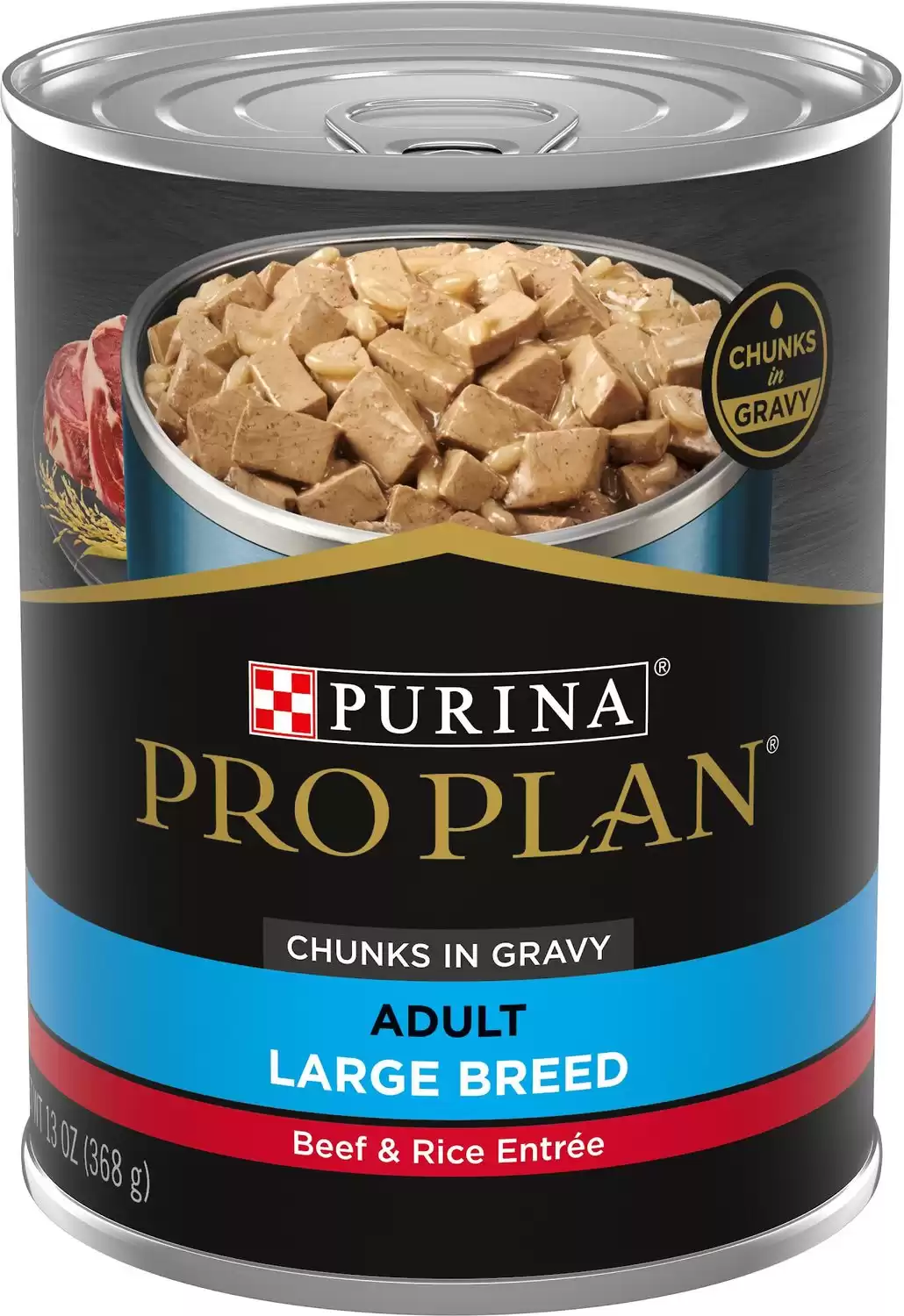Cane Corso
Canis lupus
Cane Corsos nearly became extinct in the mid 1900’s, but the breed was revived by a group of Italians. Even so, they still didn’t become known in many other parts of the world until after 1988.
Advertisement
Cane Corso Scientific Classification
- Kingdom
- Animalia
- Phylum
- Chordata
- Class
- Mammalia
- Order
- Carnivora
- Family
- Canidae
- Genus
- Canis
- Scientific Name
- Canis lupus
Read our Complete Guide to Classification of Animals.
Cane Corso Conservation Status
Cane Corso Facts
- Fun Fact
- Cane Corsos nearly became extinct in the mid 1900’s, but the breed was revived by a group of Italians. Even so, they still didn’t become known in many other parts of the world until after 1988.
- Temperament
- Confident, affectionate, and intelligent
- Diet
- Omnivore
Cane Corso as a Pet:
- General Health
- Energy Level
- Shedability
- Trainability
- Intelligence
- Tendency to Chew
- Size
- Family and kid friendliness
- Yappiness / Barking
- Silent
- Separation Anxiety
- Moderate
- Preferred Temperature
- Average climate
- Exercise Needs
- High
- Friendly With Other Dogs
- Moderate
- Pure bred cost to own
- $900 to $8,500
- Dog group
- Working
- Male weight
- 99-110 lbs
- Female weight
- 88-99 lbs
This post may contain affiliate links to our partners like Chewy, Amazon, and others. Purchasing through these helps us further the A-Z Animals mission to educate about the world's species.
View all of the Cane Corso images!
Cane Corsos nearly became extinct in the mid-1900s, but the breed was revived by a group of Italians. Even so, they still didn’t become known in many other parts of the world until after 1988.
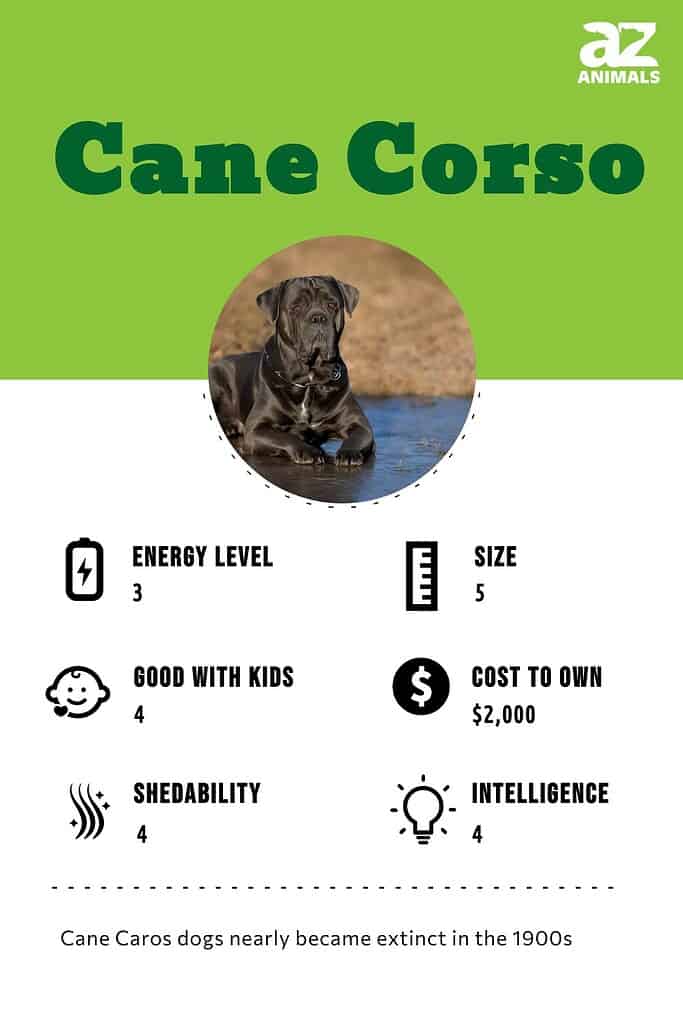
History and Origins
Cane Corsos are a large dog breed. This Italian breed was created to be a guardian dog. They fall under the larger category of molossus dogs, also called Molosers. Molosers were given their name from Molossi, who was believed to breed giant dogs, like Mastiffs, in Greece. You may also hear a Cane Corso referred to as an Italian Mastiff.
See all of our expert product reviews.
The original Cane Corsos were likely even larger than the dogs we see today. They were used in battle and would help the army charge on enemy lines. Later, they were used for other tasks such as farming, hunting wild boar, or guarding henhouses or farms. In the mid-1900s, these dogs nearly became extinct, but a group of Italians was able to bring the breed back from the brink of extinction and formed the Society of Cane Corso Lovers in Italy in 1983. It wasn’t until 1988 that the first Cane Corso came to the United States, and in 2010 that they gained recognition from the AKC.
These dogs have short coats that may be different shades of grey, black, fawn, or red. They are very confident. With the right owners, they can be very loving and affectionate toward the people they trust.
Owning a Cane Corso: 3 Pros and Cons
| Pros! | Cons! |
|---|---|
| Good family dog: As long as they are in a home with a strong and consistent leader, these dogs can make excellent family dogs. | Large: Cane Corsos are a very large breed and could accidentally injure a small child. |
| Easy to groom: These dogs are relatively easy to groom. They only require weekly brushing for most of the year and daily during their shedding seasons. | Require strong leadership: Cane Corsos can be bossy and are very intelligent. Without a strong leader and firm boundaries, they may push the boundaries. |
| Protective: They can make an excellent guard dog and are very protective of their family members. | Shorter lifespan: As a large dog breed, a Cane Corso’s lifespan is typically only 9 to 12 years. |

©Sbolotova/Shutterstock.com
Size and Weight
Cane Corsos are a large breed of dog. Males are between 24 and 28 inches tall with a weight that is proportional to their body, typically between 99 and 110 pounds. Females are slightly smaller at 23 to 26 inches and generally weigh between 88 and 99 pounds. A one-month-old puppy weighs less than 9 pounds. However, by the time the puppy reaches six months old, it may weigh between 52 and 77 pounds. These dogs are fully grown by the time they are two and a half years old.
| Height (Male) | 24 to 28 inches |
| Height (Female) | 23 to 26 inches |
| Weight (Male) | 99 to 110 pounds |
| Weight (Female) | 88 to 99 pounds |
Common Health Issues
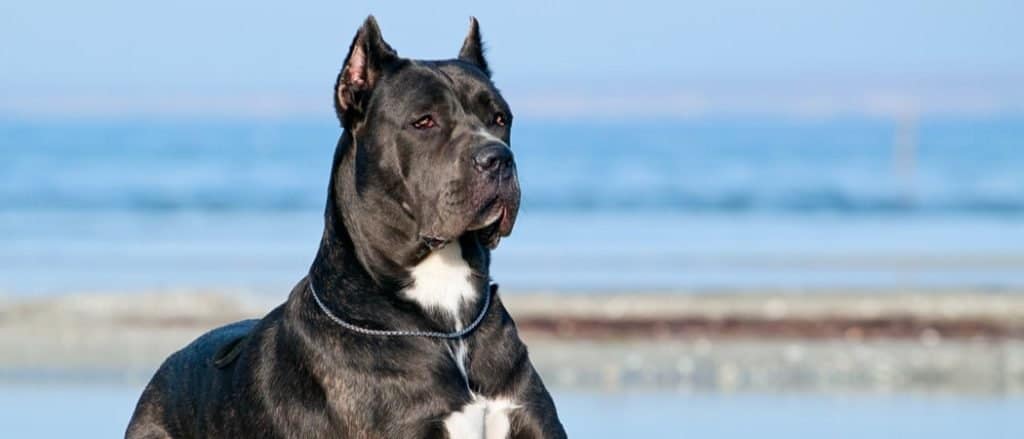
Italian Cane Corso dogs are prone to hip dysplasia.
Health and Entertainment for your Cane Corso
See all of our expert product reviews.
©Sbolotova/Shutterstock.com
All in all, this is a very healthy breed. It is important to look for reputable breeders who screen for genetic conditions to prevent them from being passed down to the puppies.
Hip dysplasia is one potential health concern. This is a condition where a dog’s hip bones don’t develop properly and rub against one another. It can be quite painful and often requires surgery. This is a genetic condition, so choosing responsible breeders can decrease the chances of your dog developing it.
Another potential concern for these dogs is idiopathic epilepsy. This condition causes dogs to suffer from recurring seizures. The cause of the seizures is unknown. This is likely an inherited condition as well.
As a large breed, they can also suffer from bloat (gastric dilation-volvulus or GDV). This condition, where the stomach becomes filled with air and twists, is life-threatening, and you should seek medical attention immediately.
To recap, some health concerns that these dogs may suffer from include:
- Hip dysplasia
- Idiopathic epilepsy
- Gastric dilation-volvulus (bloat)
Temperament and Behavior
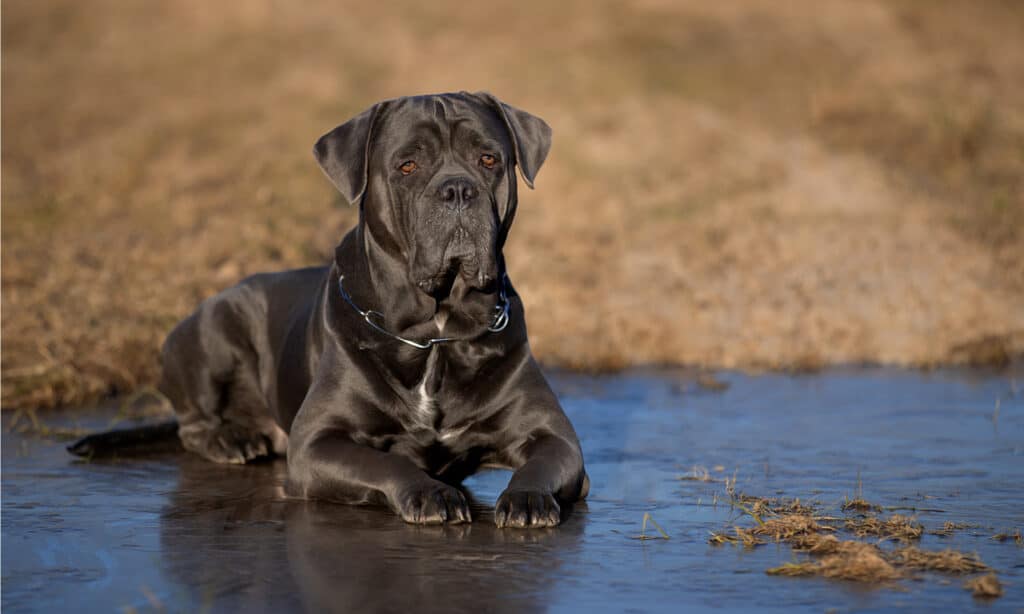
Cane Corso sheds all year round.
©Vivienstock/Shutterstock.com
Cane Corso has a very confident personality. They are also highly intelligent, and without a strong leader in the home may push the boundaries and try to assert themselves as the one who is in charge.
However, with a strong leader and trainer, Cane Corso’s traits also make them good family dogs. They can be gentle and loving with children and other members of the family. Proper socialization and training are essential to ensure any unwanted behaviors don’t occur.
How to Take Care of Them
Since each dog breed is different, the care you’ll need to provide your dog will look different from what another breed will require. As you prepare to take care of your new dog, keep their temperament, health concerns, training and socialization needs, dietary needs, and other needs in mind.
The Best Dog Food
The Cane Corso’s size can put it at risk for hip dysplasia. So it’s important to include adequate nutrition in your Cane Corso’s diet to maintain bone and joint health.
A good choice for large breeds like Cane Corsos is Purina Pro Plan Large Breed Beef & Rice Wet Dog Food.
Feeding your Cane Corso wet food like this can make bloat less likely. Since this food is specially formulated for large breeds, it has plenty of protein from beef and chicken with vitamins and Omega-6 fatty acids.
Here’s where you can find Purina Pro Plan Large Dog Wet Food on Chewy and Amazon. We also made a list of all the best food for Cane Corso here.
- Beef and rice recipe in gravy for large dog breeds
- Calcium and phosphorous for healthy bones and teeth
- Supports a healthy immune system
As a large breed dog, Cane Corsos need to eat a good amount of food each day. Most dogs require between 4 and 5 cups a day, though the exact amount can vary based on the dog’s size, age, metabolism, health concerns, and other factors. Always choose high-quality food to feed your dog. You can consult with your veterinarian if you are unsure which food to feed them or how much they should get each day.
The dietary needs of your dog will also vary based on his or her age. Puppies require smaller meals more frequently throughout the day since their stomach is not as large as an adult’s. Keep this in mind as well as you are planning to care for your dog.
Maintenance and Grooming
These dogs are relatively easy to groom. They have a double-layered coat, and their undercoat will shed some, but the shedding will be especially heavy twice a year. When they are in one of their two shedding seasons, they should be brushed daily, but other than this, their shorter coats only require weekly brushing.
Keep a dog’s nails trimmed to prevent them from getting too long and causing discomfort when walking. You should also make sure that their ears are kept clean and that their teeth are brushed regularly.
Training

Start training your Cae Corso at a young age.
©Jaromir Chalabala/Shutterstock.com
Start training a Cane Corso from a very young age. Between their large size and how dominant they can be, it is essential to begin the training and socialization process as early as possible. They do best with a strong trainer who will assert themselves as the leader of the household. Since these dogs are also very eager to please, with the right trainer, they can do very well with training, especially when positive training methods are utilized.
Exercise
These dogs were bred to perform a job, and this breed does best when they have a job or get a lot of daily exercise. Ideally, they should be taken for at least two mile-long walks each day. In addition to physical exercise, mental stimulation is also important for this breed to prevent them from engaging in destructive behaviors. You can consider signing your Cane Corso up for obedience, tracking, or agility events.
Puppies
When you bring home a puppy, be prepared for it to grow very quickly. While a two-month-old puppy only weighs between 13 and 22 pounds, this weight will triple by the time the puppy is six months old.
Puppies will need a puppy-proof area in your home, so before bringing home a dog, remove anything potentially dangerous from the areas in the home the dog will have access to. You should also purchase a dog bed, crate, leash, collar, food, and water bowls, and all the other supplies your new dog will need before bringing him or her home.
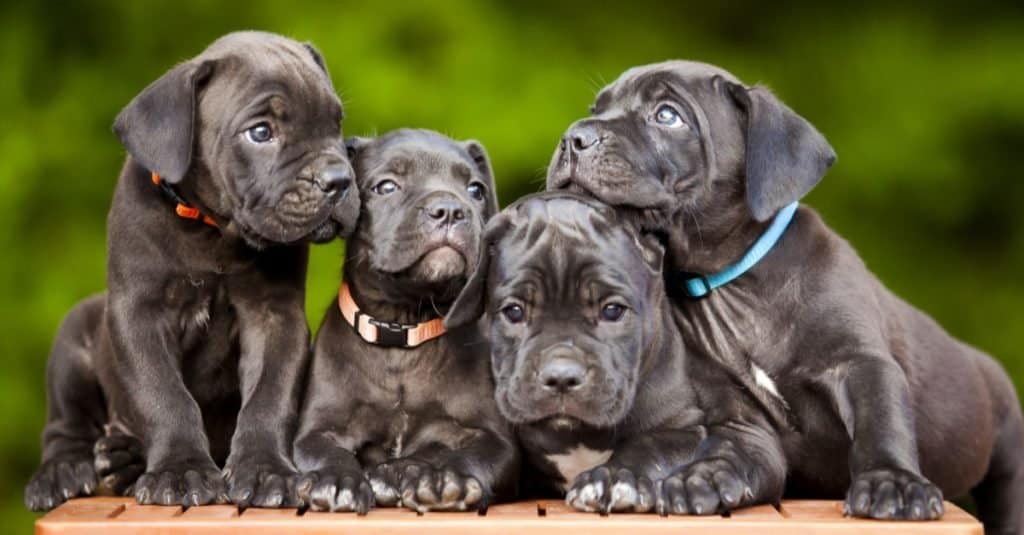
©Sbolotova/Shutterstock.com
With Children
These dogs have the potential to be excellent family dogs. They can be quite affectionate and loving with children. They also know how to be very gentle around young children. However, in order for these traits to shine through, it is important that the dog be raised in a home with a strong leader who will set clear boundaries. Also, keep in mind that this is a very large breed, and even without meaning to, a large dog could injure a small child. For this reason, it is important to always supervise children when they are around a Cane Corso.
Similar Dogs
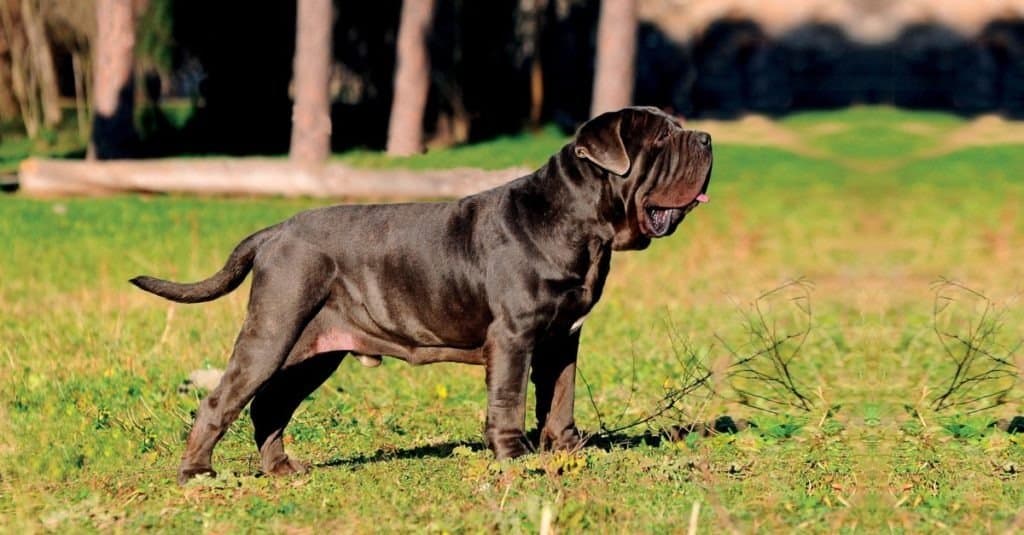
Neapolitan mastiffs are similar to Cane Corso dogs in many ways.
©Ricantimages/Shutterstock.com
Neapolitan Mastiffs, Bullmastiffs, and Rottweilers are three breeds that are similar to the Cane Corso.
- Neapolitan Mastiff: Neapolitan Mastiffs and Cane Corsos were both bred in Italy as working dogs. Both breeds are very large, but the Neapolitan Mastiff is even larger than the Cane Corso, with an average male weight of 140 pounds compared to the 104-pound average of a Cane Corso. Both breeds make an excellent watchdog, but Cane Corsos have a much higher prey drive than a Neapolitan Mastiff.
- Bullmastiff: Bullmastiffs are another working dog breed. They were bred in England, not Italy, like the Cane Corso. Both breeds are moderate shedders who don’t require too much grooming. Both breeds are very territorial, but the Bullmastiff can be better suited for homes with children.
- Rottweiler: Rottweilers are also working dogs. They were bred in Germany originally. Rottweilers and Cane Corso are around the same size, with an average male weight of 112 and 104 pounds, respectively. Males in both breeds are also around the same height, at 24 to 27 inches tall. The Rottweiler was first recognized by the American Kennel Club in 1931, but it wasn’t until 2010 that the Cane Corso was first recognized.
Famous Cane Corsos
There are a few celebrities that own Cane Corso:
- Lexi is Sherri Shepherd’s, Cane Corso.
- Roman is Vin Diesel’s, Cane Corso.
Popular Names
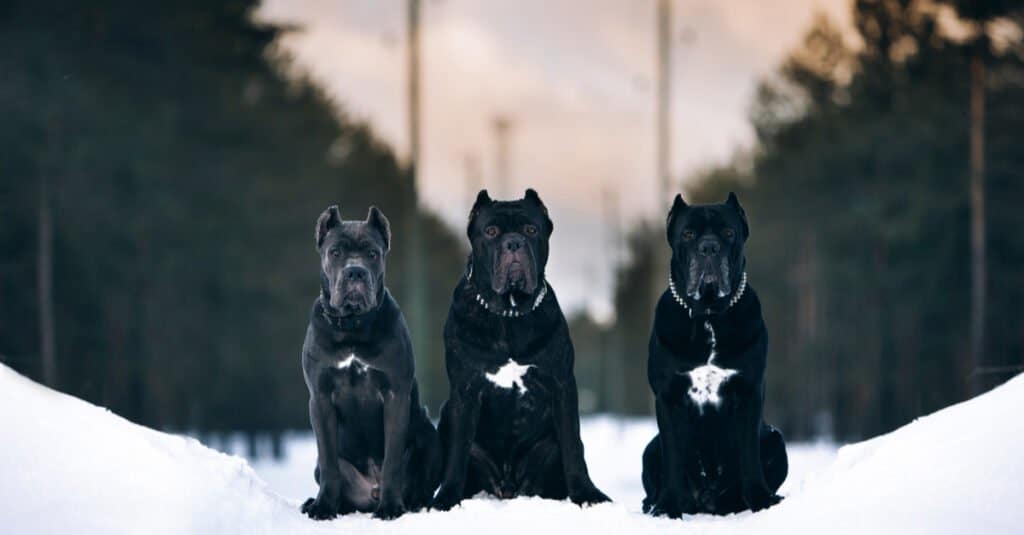
Cane Corsos are known to be empathetic.
©BoJack/Shutterstock.com
Need the right name for your dog? See if one of the options below feels like a good fit:
- Zeus
- King
- Apollo
- Brutus
- Odin
- Bella
- Luna
- Piper
- Roxy
- Zoe
Cane Corso FAQs (Frequently Asked Questions)
How much does a Cane Corso cost to own?
While the exact price to purchase a Cane Corso from one of the breeders in your area will likely vary, generally this breed is priced between $900 and $2,000. However, there will be some Cane Corsos available from different breeders that cost as much as $8,500. The higher price tag of these dogs would indicate a superior parental lineage. Sometimes you may also be able to find a Cane Corso up for adoption through a rescue organization or shelter. The price to adopt will vary based on location and other factors but typically costs around $200 to $400.
Some popular Cane Corso mixes, such as the Blue Blood Cane Corso, Cane Corxer, or Labrador Corso, may also be available for purchase or adoption. The price to purchase a hybrid breed can range from $700 to over $2,500.
As you determine whether you have the money in your budget to adopt a Cane Corso, consider the other costs associated with owning this breed. As a large breed, they will need more food than smaller breeds, which can add up in price. You’ll also need to purchase additional supplies, training, and veterinary care for the dog. This can cost at least $1,000 to $1,500 the first year you own the dog. In the following years, you should budget at least $500 to $1,000 for taking care of your dog.
How long does Cane Corso live?
Cane Corsos typically live between 9 and 12 years.
What is a Cane Corso?
A Cane Corso is a large dog that was originally bred in Italy. They are a type of working dog breed known as mollosers. They were bred to be guardian dogs and were even used during battle. Later, they were used as for hunting, farming, and guarding henhouses. Cane Corsos are also known as Italian Mastiffs. Cane Corsos may be different colors including black, light grey, dark grey, red, or fawn.
In addition to finding purebred Cane Corsos, you may also find mixed breeds such as Blue Blood Cane Corsos (a Cane Corso mixed with an Alapaha Blue Blood Bulldog) or American Pit Corsos (A Cane Corso mixed with an American Pit Bull Terrier).
How easy is it to train a Cane Corso?
With a strong trainer who is able to assert his leadership, Cane Corsos can be relatively easy to train. While they have a desire to be dominant and protective, this breed also aims to please its owners. They do best when positive training methods are used.
Is a Cane Corso a good family dog?
Yes, a Cane Corso can make a good family dog as long they receive proper training and have a strong leader in the home. This breed is loving, affectionate, and knows how to be gentle with a child. They are very large though, and due to their size could accidentally hurt a smaller child.
Are Cane Corsos aggressive?
Cane Corsos can be aggressive if they are not properly trained. However, with proper training and socialization, this breed can be very friendly and affectionate.
Are Cane Corsos banned?
Cane Corsos are banned in some areas including select cities in Colorado, Nebraska, Kansas, Arkansas, Idaho, Washington, and South Dakota.
What is the difference between a Cane Corso and a Presa Canario?
The Presa Canario and the Cane Corso are often mistaken for each other, as they occasionally share a similar fawn coloration and overall appearance. Both are classified as large breed dogs and have a short coat of fur with little shedding.
What is the difference between a Cane Corso and a pit bull?
In physical appearance, the Cane Corso and the pit bull are unlikely to be confused for each other. The Corso is a large breed, while the pit is a medium-sized dog.
What are the differences between Mastiffs and Cane Corsos?
The key differences between the Mastiff and the Cane Corso are in terms of personality, temperament, and of course, size.
The Cane Corso and the Mastiff have unique personalities and temperaments. While these two dogs may look similar, they have dissimilar training needs. Prospective owners of either breed will need to provide specialized obedience training suited to their dog, especially in the case of the inexperienced owner.
What is the difference between a Cane Corso and a Doberman?
The main differences between a Cane Corso and a Doberman are size, appearance, temperament, and origin.
The most notable difference is in their personalities. Whereas the Doberman is protective and alert, Cane Corso is reserved, independent, and even gentle. In fact, beneath its tough exterior, it is quite the affectionate dog.
What's the difference between a Cane Corso and a Kangal?
The Kangal is larger than the Cane Corso, and the Cane Corso has a slightly shorter lifespan than the Kangal. Additionally, the Kangal was originally bred in Turkey, while the Cane Corso originated in Italy.
What's the difference between a Cane Corso and a Dogo Argentino?
Both the Cane Cross and the Dogo Argentino are large and loyal working dog breeds. The main differences between them are their coloration and exercise requirements. In addition, the Dogo Argentino can have a tendency to develop hearing problems.
Thank you for reading! Have some feedback for us? Contact the AZ Animals editorial team.
Sources
- American Kennel Club, Available here: https://www.akc.org/dog-breeds/cane-corso/
- Dogtime, Available here: https://dogtime.com/dog-breeds/cane-corso#/slide/1
- Wikipedia, Available here: https://en.wikipedia.org/wiki/Cane_Corso
- Daily Paws, Available here: https://www.dailypaws.com/dogs-puppies/dog-breeds/cane-corso
- Wag!, Available here: https://wagwalking.com/breed/blue-blood-cane-corso#:~:text=The%20Blue%20Blood%20Cane%20Corso,similar%20in%20size%20and%20temperament.&text=The%20Alapaha%20is%20a%20rare,Corso%20hybrid%20even%20more%20so.
- Dog Designer, Available here: https://doggiedesigner.com/blue-blood-cane-corso/
- K9 Research Lab, Available here: https://www.k9rl.com/most-banned-dog-breeds/
- Dogell, Available here: https://dogell.com/en/compare-dog-breeds/rottweiler-vs-cane-corso-vs-boerboel





